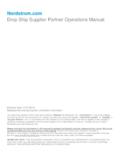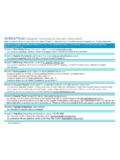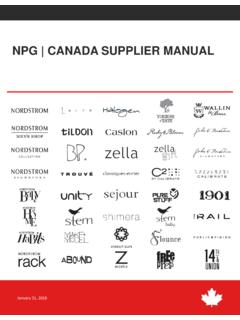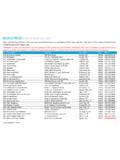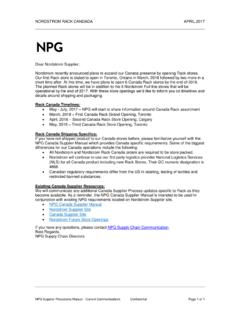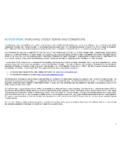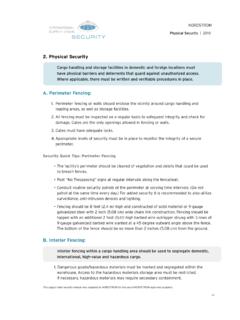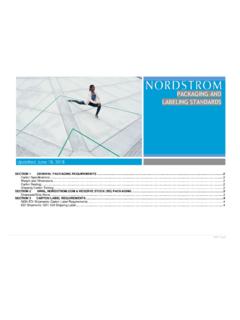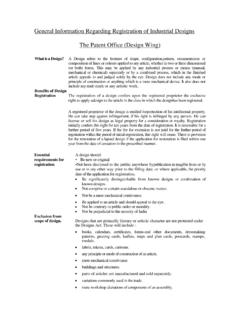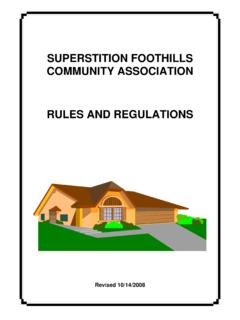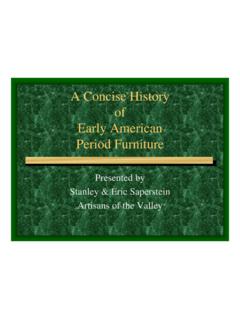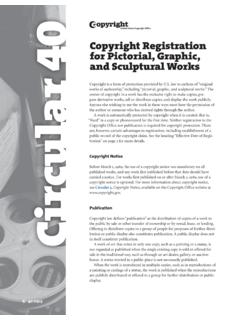Transcription of Textile Fiber Labeling - Nordstrom
1 Textile Fiber Labeling AUGUST 2010 NPG Supplier Procedures Manual 2010 Nordstrom , Inc., all rights reserved. CONFIDENTIAL: These documents contain proprietary, trade secret, and confidential information which are the property of Nordstrom , Inc. These documents and their contents may not be duplicated or disclosed to any other party without express authorization of Nordstrom , Inc. Page 1 of 5 1 The Federal Trade Commission (FTC) regulates the Textile Fiber Products Identification and Wool Products Labeling Acts. By law, the Fiber content needs to be properly identified on the garment. The general requirements are summarized below. Textile Fiber PRODUCTS IDENTIFICATION ACT 1. Generic Names: The Fiber content must be disclosed using the generic name of the Fiber in English. In 1998, the FTC has amended the list to include generic Fiber names for manmade fibers from ISO Standard 2076:1989 (see list below).
2 Abbreviations and symbols such as ditto marks and asterisks are prohibited. Natural: Generic names of natural fibers are: COTTON WOOL SILK LINEN RAMIE HEMP Manmade: One of the following generic names must be used for a manmade Fiber : ACETATE MODAL ACRYLIC NOVALID ALGINATE NYLON ANIDEX NYTRIL ARAMID OLEFIN AZLON PBI CARBON POLYAMIDE CHLOROFIBRE POLYESTER CUPRO POLYETHYLENE ELASTANE POLYPROPYLENE ELASTERELL-P PLA ELASTODIENE RAYON ELASTOESTER RUBBER FLUROFIBER SARAN GLASS SPANDEX LASTOL SULPHUR LASTRIL TRIACETATE LYOCELL VINAL METAL Fiber VINYAL METALLIC
3 VINYONL MODACRYLIC VISCOSE Fiber trade names such as Lycra and Tencel can be used in conjunction with the generic name, but cannot be used by themselves. Example: 100% TENCEL LYOCELL If using a trade name, it is important that you have legal documentation that the product is manufactured by the company with the registered trademark. Otherwise, you violate the trademark and legal action can be taken against your company. 2. Fibers Present in Amounts of 5% or Greater: All fibers present in the amount of 5% or greater need to be listed on the content label, in order of dominance, from the highest percentage to the lowest percentage. Example: 65% POLYESTER 35% COTTON Textile Fiber Labeling AUGUST 2010 NPG Supplier Procedures Manual 2010 Nordstrom , Inc.
4 , all rights reserved. CONFIDENTIAL: These documents contain proprietary, trade secret, and confidential information which are the property of Nordstrom , Inc. These documents and their contents may not be duplicated or disclosed to any other party without express authorization of Nordstrom , Inc. Page 2 of 5 23. Fibers Present in an Amount of Less than 5%: All fibers present in an amount of less than 5% shall be identified as other Fiber . However, if the Fiber has a definite functional significance, the generic name may be disclosed. As of March 16, 1998, as amended by the FTC, it is no longer necessary to include the functional significance on the label. Example #1: 96% COTTON 4% OTHER Fiber OR 96% COTTON 4% SPANDEX Note: Functional significance for Spandex is elasticity. Example #2: Actual Fiber Content 92% COTTON 4% NYLON 4% RAYON Required Labeling 92% COTTON 8% OTHER FIBERS 4.
5 Tolerances: Single Fiber : No tolerance exists for products labeled 100% or All . 100% or All means that a Textile Fiber product is comprised wholly of one Fiber . Example: For heather fabrics, Polyester or Rayon is usually combined with Cotton to achieve the heather effect; therefore, the Fiber content cannot be labeled "100% Cotton". If the actual Fiber content is 99% Cotton/1% Polyester, it must be labeled: 99% COTTON 1% OTHER Fiber More than one Fiber : A 3% tolerance is allowed for products containing more than one Fiber . This means that a Textile product is correctly branded if the actual content does not vary by more than 3% from the percentages stated on the label. Example: Labeled 80% COTTON 20% POLYESTER Actual Content /Allowed Tolerance 77- 83% COTTON 17-23% POLYESTER 5. Ornamentation: If the ornamentation is a different Fiber content than the body of the garment and does not exceed 5% of the total Fiber weight of the garment, the term EXCLUSIVE OF ORNAMENTATION can be used.
6 Metallic and embroidery threads are considered ornamentation. Example: 60% COTTON 40% POLYESTER EXCLUSIVE OF ORNAMENTATION Textile Fiber Labeling AUGUST 2010 NPG Supplier Procedures Manual 2010 Nordstrom , Inc., all rights reserved. CONFIDENTIAL: These documents contain proprietary, trade secret, and confidential information which are the property of Nordstrom , Inc. These documents and their contents may not be duplicated or disclosed to any other party without express authorization of Nordstrom , Inc. Page 3 of 5 36. Trimmings and Findings: If the trim is a different Fiber content than the body of the garment but does not exceed 15% of the total surface area of the garment, the term Exclusive of Decoration can be used. Trims and findings include rickrack, tape, belting, binding, braid, decorative labels, collars, cuffs, appliqu s, elastics, etc.
7 Example: 55% LINEN 45% COTTON EXCLUSIVE OF DECORATION 7. Linings, Interlinings, Fillings and Paddings: Products containing linings, interlinings, fillings and paddings that are incorporated into the garment for warmth rather than for structural purposes must be identified as such on the Fiber content label. Example: SHELL: 100% COTTON LINING: 100% NYLON FILLING: 100% POLYESTER 8. Sectional Disclosure: If a product has two or more sections that are composed of different Fiber contents, the Fiber content of the various sections can be shown separately. Example: FRONT & SLEEVES: SUEDE BACK & COLLAR: 100% MERINO WOOL 9. Coated Fabrics: Coated fabrics are those that are coated, filled, impregnated or laminated with a continuous film, in such a manner as to add at least 35 percent weight to the base fabric.
8 Examples of coating films are: Polyurethane (PU), Polyvinyl Chloride (PVC) and Acrylic resin The coating is not a Fiber and should not be identified as a percentage in the Fiber content. However, if you choose to identify the coating, please follow the example below. Example: 100% COTTON POLYURETHANE COATED WOOL PRODUCTS Labeling ACT 1. Fibers Present in an Amount of Less than 5%: Wool or recycled wool must always be disclosed by name and percentage weight, even if it is less than five percent of the product. 2. Specialty Fibers That May Be Describes as Wool: SHEEP *LAMB ANGORA GOAT CASHMERE GOAT CAMEL ALPACA LLAMA VICUNA Textile Fiber Labeling AUGUST 2010 NPG Supplier Procedures Manual 2010 Nordstrom , Inc.
9 , all rights reserved. CONFIDENTIAL: These documents contain proprietary, trade secret, and confidential information which are the property of Nordstrom , Inc. These documents and their contents may not be duplicated or disclosed to any other party without express authorization of Nordstrom , Inc. Page 4 of 5 4 Example: 60% WOOL 30% NYLON 10% ALPACA OR 70% WOOL 30% NYLON * Note: If Lambs Wool is used in the Fiber content it is two words and should be labeled as "LAMBS' WOOL" 3. Specialty Fibers That May Be Used Instead of the Word the Wool: MOHAIR CASHMERE CAMEL HAIR VICUNA LLAMA ALPACA Example: 55% ALPACA 45% CAMEL HAIR Note: Mohair is the hair of an Angora goat. 4. Crossbreeding: As of March 16, 1998, the Wool Products Labeling Act has been amended to allow Labeling of hair or Fiber obtained as the result of crossbreeding two wool-producing animals.
10 Examples: 100% CASHGORA (crossbreed Cashmere & Angora) 100% PACO VICUNA (crossbreed Alpaca & Vicuna) 5. Use of the Terms Virgin or New : These terms can only be used to describe wool that is composed of new or virgin fibers, which have never been reclaimed or recycled. Example: 100% VIRGIN WOOL 6. Use of the Term Recycled : The term "recycled wool" must be specified on the Fiber content label if the wool has been reclaimed from a product previously spun, knitted, woven or made into a Textile product. Example: 60% RECYCLED ALPACA 40% RAYON MULTI- STATE FUR Labeling REQUIREMENTS (EFFECTIVE 11-16-07) Several States have signed into law an amendment to the General Business Law adding additional fur Labeling requirements. The law(s) requires that apparel which contains natural or imitation fur, must be labeled with the terms Real Fur or Faux Fur . The amendment makes it unlawful for any person or corporation to knowingly import, sell or manufacture articles of clothing which include, or have any attachment in any quantity or of any value, fur that is not labeled as being faux (artificial) or real fur.

